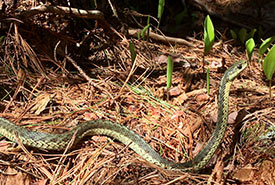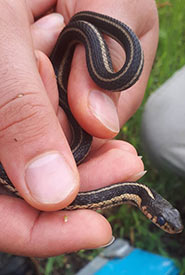Snakes, saints and sightings: What you can do to help uncover the mystery of gartersnakes in Newfoundland

Maritime gartersnake enjoying the sun. Maritime gartersnakes are likely one of two subspecies of common gartersnake observed in Newfoundland, and can be identified by their green-brown colouration and mottled pattern. (Photo by Prof. Julia Riley)
By Andrea Gigeroff, Prof. James Baxter-Gilbert and Prof. Julia Riley
According to legend, the reason that there are no snakes in Ireland is because St. Patrick banished them into the sea some time in the fifth century CE. Ecologically, we know that there were never any snakes in Ireland post-glaciation. If anything, it was the ice sheets that drove them out tens to hundreds of thousands of years ago. The St. Patrick's story was probably symbolic. Perhaps an allegory for changing times.
Newfoundland is sometimes compared to Ireland for its beautiful scenery and lively culture. Yet the island shares another feature of the Emerald Isle: historically there were never any snakes in Newfoundland either. But much like the Irish of 1,500 years ago, we too are living in changing times and the island is now home to snakes!
The first confirmed report of a snake on Newfoundland was a common gartersnake found in the St. David's area in 2010. Later in 2015, a few more gartersnakes were observed on the east side of the island near St. John's. Now remember, there are no native reptiles here, which means these snakes were likely introduced to Newfoundland, either accidentally, maybe as stowaways in imported hay and other materials, or intentionally, as released pets. To date, no one knows.
Newfoundland is at the northern limit of where most reptiles, including snakes, can survive in Canada. But common gartersnakes are tough. Thriving coast to coast across Canada, they can even be found as far north as the southern Northwest Territories. What makes this snake such a survivor? They are both diet and habitat generalists, which means they can live in a variety of ecosystems, from wetlands, to farm fields, to forests, to urban parks. And they can eat a variety of foods, from earthworms and insects, to frogs and salamanders, and even small mammals and birds. Not being too picky can really give you a leg up — even if you don’t have any legs.
The luck of the Irish may be with Newfoundlanders with respect to which snake arrived. This is because common gartersnakes are not harmful to people or pets. They are small snakes, under one metre long, and are non-venomous, with only tiny teeth built for holding on to prey. As a result, they are far more scared of you than you are of them, and will usually flee or hide when approached by a person, dog or cat.
But what does the arrival of these snakes mean for Newfoundland’s ecosystems and biodiversity? Will another non-native animal added to the mix spell trouble for the island’s unique, endemic and beloved species? Were they released by people or is this a natural process and the snakes made it here on their own? These are some of the important questions that researchers are now gearing up to answer.

Eastern gartersnakes are likely of two subspecies of common gartersnake observed in Newfoundland and can be identified by their black colouration and bold stripes. (Photo by Andrea Gigeroff)
A team led by Andrea Gigeroff, a PhD student at Laurentian University, is hoping to begin uncovering some of the mysteries surrounding this “reverse St. Patrick’s-ing” of Newfoundland. Working with Prof. Jackie Litzgus (Laurentian University), Prof. Julia Riley and Prof. James Baxter-Gilbert (Mount Allison University), the Newfoundland Parks Division and Newfoundland Wildlife Division, and the Nature Conservancy of Canada (NCC), this research team’s collective goals are to gather information on the snakes’ genetics, what they have been eating and their general comings and goings. With this data in hand, the team hopes to determine where the snakes came from, how they got here, and begin to understand whether they are negatively affecting native species populations.
This work is part of Riley's and Baxter-Gilbert’s larger research program to study the ecology and conservation of reptiles and amphibians in Atlantic Canada, and the impacts of introduced reptiles and amphibians in Newfoundland.
NCC nature reserves will serve as survey and sample sites across the island for the research team. NCC staff will learn about the results of the common gartersnake survey and will put this knowledge to work on the remote nature reserves that researchers are not able to access. As a conservation organization keenly aware of the impacts that new species can have on native ecosystems, NCC is responsible for monitoring and, when necessary, managing new species that could become problematic for native species on our nature reserves — often in collaboration with researchers.
In addition to common gartersnakes, there are several introduced amphibians to Newfoundland, including green frogs, wood frogs, mink frogs, American toads and eastern red-backed salamanders. And these researchers need your help to figure out where non-native reptile and amphibian species are turning up.
The first step of advancing research on what these species are doing, and how they may be impacting island ecosystems, is knowing where they are. So, if you see any wild species of reptile or amphibian, be sure to log your sighting on an online repository (like iNaturalist), email rileylabmta@gmail.com to report it to our research team, and/or report them directly to your local Wildlife Division office by calling 709-637-2025.
As we move closer and closer to spring, toast St, Patrick and gear up for the warmer weather ahead, be sure to download your favourite nature reporting app and brush up on your reptile- and amphibian-spotting skills. It may have taken an entire ice sheet to rid Ireland of its snakes, but it will take all of us keeping our eyes peeled and sharing our sightings to help advance our understanding of how common gartersnakes came to be found in Newfoundland and if the addition of this non-native reptile is upsetting the ecological balance.



